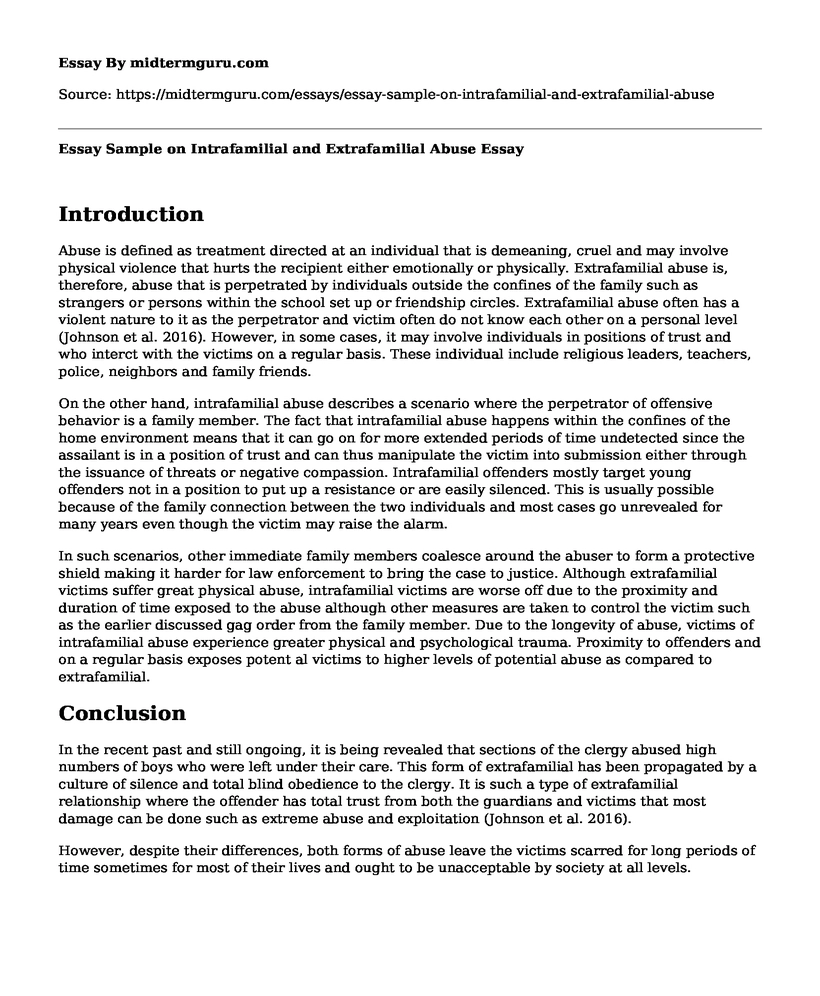Introduction
Abuse is defined as treatment directed at an individual that is demeaning, cruel and may involve physical violence that hurts the recipient either emotionally or physically. Extrafamilial abuse is, therefore, abuse that is perpetrated by individuals outside the confines of the family such as strangers or persons within the school set up or friendship circles. Extrafamilial abuse often has a violent nature to it as the perpetrator and victim often do not know each other on a personal level (Johnson et al. 2016). However, in some cases, it may involve individuals in positions of trust and who interct with the victims on a regular basis. These individual include religious leaders, teachers, police, neighbors and family friends.
On the other hand, intrafamilial abuse describes a scenario where the perpetrator of offensive behavior is a family member. The fact that intrafamilial abuse happens within the confines of the home environment means that it can go on for more extended periods of time undetected since the assailant is in a position of trust and can thus manipulate the victim into submission either through the issuance of threats or negative compassion. Intrafamilial offenders mostly target young offenders not in a position to put up a resistance or are easily silenced. This is usually possible because of the family connection between the two individuals and most cases go unrevealed for many years even though the victim may raise the alarm.
In such scenarios, other immediate family members coalesce around the abuser to form a protective shield making it harder for law enforcement to bring the case to justice. Although extrafamilial victims suffer great physical abuse, intrafamilial victims are worse off due to the proximity and duration of time exposed to the abuse although other measures are taken to control the victim such as the earlier discussed gag order from the family member. Due to the longevity of abuse, victims of intrafamilial abuse experience greater physical and psychological trauma. Proximity to offenders and on a regular basis exposes potent al victims to higher levels of potential abuse as compared to extrafamilial.
Conclusion
In the recent past and still ongoing, it is being revealed that sections of the clergy abused high numbers of boys who were left under their care. This form of extrafamilial has been propagated by a culture of silence and total blind obedience to the clergy. It is such a type of extrafamilial relationship where the offender has total trust from both the guardians and victims that most damage can be done such as extreme abuse and exploitation (Johnson et al. 2016).
However, despite their differences, both forms of abuse leave the victims scarred for long periods of time sometimes for most of their lives and ought to be unacceptable by society at all levels.
References
Johnson, H. C., Underwood, L. A., Baum, L. J., & Newmeyer, M. (2016). Differences in Risk Scores among Intrafamilial and Extrafamilial Sexual Offenders. International Journal of Emergency Mental Health and Human Resilience, 18 (2), 742-751.
Cite this page
Essay Sample on Intrafamilial and Extrafamilial Abuse. (2022, Sep 21). Retrieved from https://midtermguru.com/essays/essay-sample-on-intrafamilial-and-extrafamilial-abuse
If you are the original author of this essay and no longer wish to have it published on the midtermguru.com website, please click below to request its removal:
- Literature Review on Prevention in the Vulnerability to Substance Abuse - Paper Example
- Essay Sample on Legalization of Marijuana in the United States
- Paper Example on Security and Cyberterrorism
- Critical Essay on Stealing Joy
- The Use of Telemedicine To Provide or Enhance Substance Abuse Services in Underserved Areas - Essay Sample
- Veteran Suicide: A Growing Tragedy - Research Paper
- Should Physicians Perform Euthanasia? Investigating the Right to Physician-Assisted Suicide - Essay Sample







